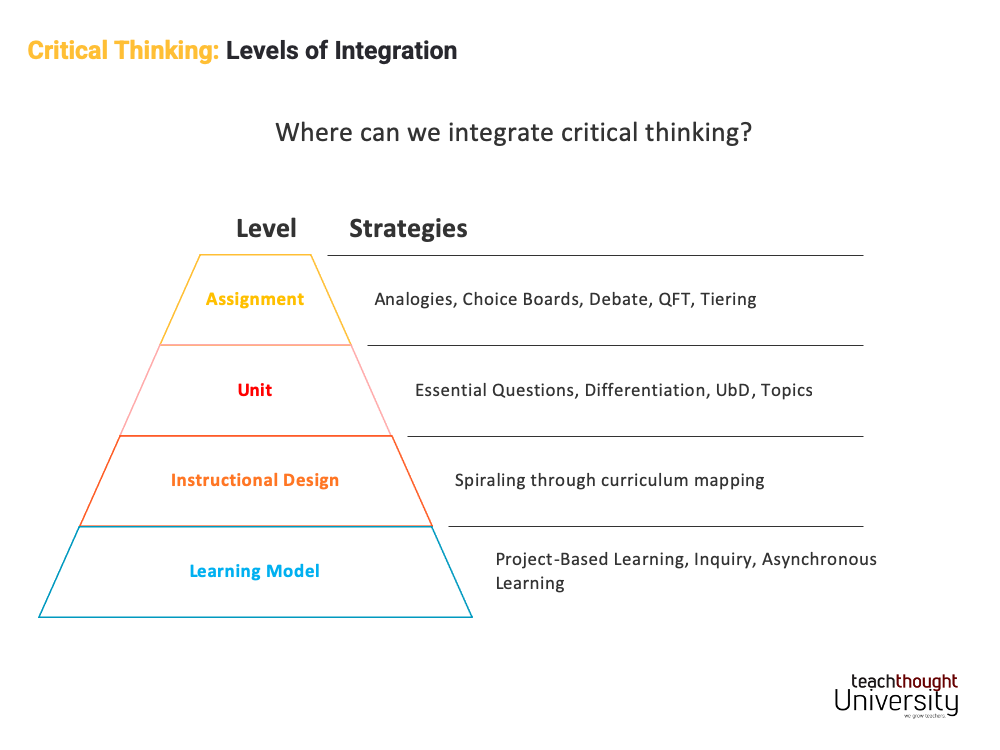
[ad_1]
A Basic Framework For Teaching Critical Thinking In School
by Terrell Heick
In What Does Critical Thinking Mean?, we offered that ‘(c)ritical thinking is the suspension of judgment while identifying biases and underlying assumptions to draw accurate conclusions.’
Of course, there are different definitions of critical thinking. The American Philosophical Association defines it as, “Critical thinking is the ability to think clearly and rationally, understanding the logical connection between ideas. It involves being active (rather than reactive) in your learning process, and it includes open-mindedness, inquisitiveness, and the ability to examine and evaluate ideas, arguments, and points of view.”
But understanding exactly what it is and means is different than teaching critical thinking–that is, consistently integrating it in your units, lessons, and activities. Models and frameworks have always been, to me, helpful in making sense of complex (or confusing–which is generally different than complex) ideas. I also find them to be a wonderful way to communicate any of that sense-making.
Put another way, models and frameworks can help to think about and communicate concepts.
See also Examples Of Analogies For Critical Thinking
A Framework Integrating Critical Thinking In Your Classroom
Obviously, teaching critical thinking in a classroom is different than ‘teaching’ it outside of one, just as it differs from the active practice and application of critical thinking skills in the ‘real world.’ I have always taught students that critical thinking is something they do seamlessly in their lives.
They analyze plots and characters in movies.
They create making short videos.
They critique relationships and punishments and grades and video games.
They evaluate their favorite athletes’ performance and make judgments about music.
And so on. With that context out of the way, let’s have a look at the framework, shall we?
Levels Of Integration Of Critical Thinking

Preface: This post is necessarily incomplete. A full how-to guide for teaching critical thinking would be done best as a book or course rather a blog post. The idea is to offer a way to think about teaching critical thinking.
Critical thinking can be done at the…
Assignment-Level Integration Strategies
-Analogies (see also Teaching With Analogies)
-Choice Boards
-Debate
-The Question Formulation Technique
-Tiering
Unit-Level Integration Strategies
-Essential Questions (see How To Use Essential Questions)
-Differentiation (see also Ways To Differentiate Instruction)
-Understanding by Design (any of the elements of the UbD framework–backward design, for example)
-Topics (i.e., learning about topics that naturally encourage or even require critical thinking)
See also 6 Critical Thinking Questions For Any Situation
Instructional Design-Level Integration Strategies
-Spiraling (in this case, at the curriculum mapping level)
Learning Model-Level Integration Strategies
-Project-Based Learning (see 25 Questions To Guide Teaching With Project-Based Learning)
-Inquiry Learning (see 14 Teaching Strategies For Inquiry-Based Learning)
-Asynchronous Self-Directed Learning (see our Self-Directed Learning Model)
Source link




